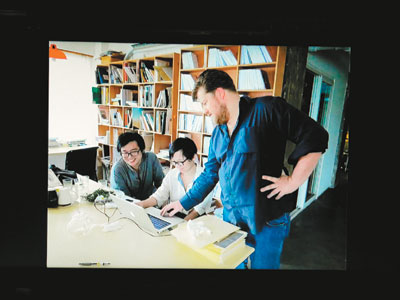
Anne Zhang
zhangy49@gmail.com
A TOTAL of 97 ink paintings by 49 artists from China and South Korea depict their homelands. The depictions feature green pines, red plums, distant hills, nearby ponds and other things that make up an idyllic landscape.
The Ninth Exchange Exhibition of Sino-South Korea Ink Painting is being held at the Guan Shanyue Art Museum in Futian District until Nov. 18.
Initiated in 2004, the annual ink-painting exhibition is co-sponsored by the Guan Shanyue Art Museum in Shenzhen and the Yizhai Art Museum in Gwangju, South Korea.
“Ink painting is a carrier of the Oriental art spirit and maintains the genes and traits of the Oriental nations,” director of the Guan Shanyue Art Museum Chen Xiangbo said at the opening ceremony of the exhibition.
Chen said advanced technologies have greatly enriched human being’s material lives, but at the same time, people’s spiritual world has become barren. Titled “Oriental Homeland,” the exhibition is aimed at inspiring people to think about their spiritual connections with their homeland.
“Different artists have distinct understandings of their Oriental homeland,” said Chen Junyu, research and collection director at the Guan Shanyue Art Museum.
In the painting “Dancing With the Wind,” artist Ma Shunxian depicts a peaceful and beautiful mountainous landscape in which several remote farm houses can be seen through mist.
Ma is outstanding in the field of contemporary Chinese painting and calligraphy. Carrying on some traditions of Chinese painting, his works stress craftsmanship and artistic conception. He skillfully integrates contemporary ethos into his traditional ink paintings.
Female artist Chen Danzhi has two works on exhibition, both of which are about orchids. Orchids are a popular subject in traditional Chinese painting. Chen’s paintings demonstrate the flower’s spirit of purity and elegance.
“From a female perspective, Chen infuses her understanding of the Oriental spirit into the paintings,” Chen Junyu said.
South Korean artist Yoon Nam-woong’s works are unique among the exhibits. Titled “Music of Lotus Pond,” his two paintings look more like cartoons than ink paintings. With simple strokes, he depicts a man sitting in a boat, angling in a pond. The angler could be a scholar, a poet, or a farmer.
“Any man could imagine himself to be the man fishing in a pond,” Yoon said.
Chen Junyu said China and Korea have had cultural and art exchanges since the Ming Dynasty (1368-1644) and thus, artists of the two countries have a lot in common in artistic creation. “Meanwhile, both China and South Korea face a critical environmental challenge while enjoying rocketing economic growth,” he said. “How do artists perceive the challenge?”
Korean artist Kim Cheon-il answered Chen’s question with his work “A View of Dokodo Island,” which realistically reveals the island and its surroundings. “Every artist has the responsibility to offer a realistic demonstration of his/her surroundings including both the natural environment and the social and cultural environment,” Kim said.
|

